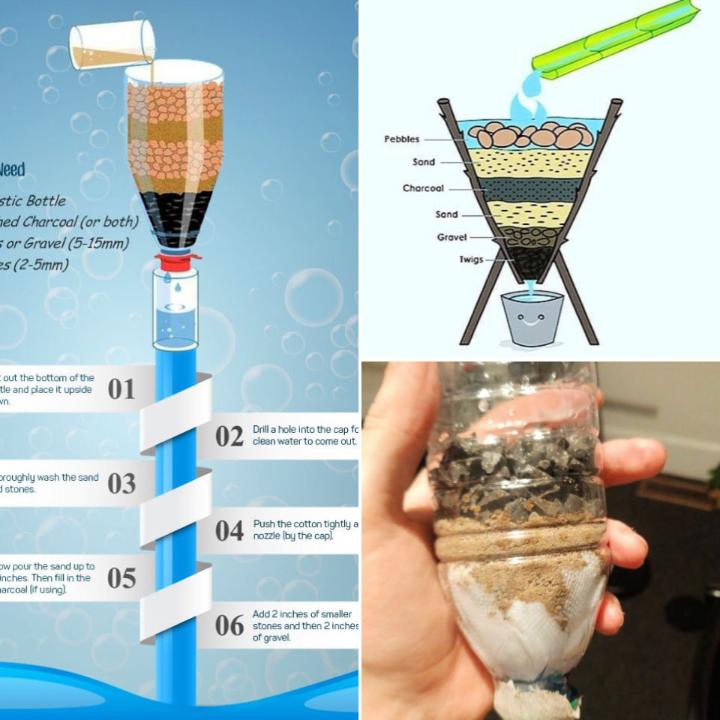If you’ve been wondering how to filter your water without breaking the bank, look no further. In this article, we’ll explore some budget-friendly options to help you get clean and safe drinking water in your own home. With a range of innovative and cost-effective solutions, you’ll discover how easy it is to achieve purity without sacrificing your wallet. So, whether you’re concerned about the quality of your tap water or looking for a more sustainable alternative, read on to find out how you can effectively and affordably filter your water.
1. Use Charcoal Filters
1.1 Homemade Charcoal Filter
If you’re looking to filter your water cheaply and effectively, one option is to create your own homemade charcoal filter. Charcoal has been used for centuries as a natural way to purify water, thanks to its porous structure that helps trap impurities. To make a homemade charcoal filter, you’ll need a few basic supplies: a clean container, activated charcoal, gravel, and sand.
First, find a container that is large enough to hold the amount of water you want to filter. Clean the container thoroughly to ensure it is free from any contaminants. Next, layer the bottom of the container with a few inches of gravel, followed by a layer of sand. This will help to remove larger impurities from the water.
Now it’s time to add the star of the show – activated charcoal. Activated charcoal can be purchased at most pet stores or online. Pour a layer of activated charcoal on top of the sand, making sure to cover it completely. The charcoal will absorb toxins, chemicals, and odors present in the water.
Repeat the layers of sand and gravel until you reach the top of the container. Finally, pour the water you wish to filter into the container and let it slowly trickle through the layers of charcoal, sand, and gravel. The water that comes out of the container should be cleaner and safer to drink.
1.2 Store-Bought Charcoal Filters
If you don’t have the time or resources to create your own homemade charcoal filter, don’t worry – there are plenty of affordable store-bought charcoal filters available on the market. These filters are typically designed to fit directly onto your faucet or can be used with a water pitcher.
To use a store-bought charcoal filter, simply follow the instructions provided by the manufacturer. Most filters will require you to remove any pre-existing aerators from your faucet, attach the filter, and then allow the water to flow through it. These filters work by passing the water through a carbon block or granulated activated carbon, effectively removing impurities and improving taste.
While these store-bought charcoal filters may be more convenient, they can be just as effective at purifying your water as a homemade charcoal filter. Plus, they often come with additional features such as a filter life indicator, which lets you know when it’s time to replace the filter.
2. Utilize Boiling Method
2.1 Bring Water to a Boil
Boiling water is one of the simplest and most traditional methods of water purification. This method is particularly effective against harmful bacteria, viruses, and parasites that may be present in your water. To utilize the boiling method, start by filling a clean pot with water and placing it on the stove.
Bring the water to a rolling boil and let it continue boiling for at least one minute. If you live at high altitudes, it is recommended to let the water boil for three minutes to ensure all pathogens are killed. Make sure to cover the pot while boiling to prevent contaminants from re-entering the water.
2.2 Allow Water to Cool and Settle
After boiling the water, it is important to let it cool down before drinking or using it. During the cooling process, any sediment or particles that may have been present in the water will settle to the bottom of the container. Once the water has cooled, carefully pour it into a clean container, making sure not to disturb the sediment at the bottom.
To further improve the taste of boiled water, you can consider pouring it through a fine mesh strainer lined with a coffee filter or cheesecloth. This will help remove any remaining debris or particles that may affect the clarity of the water. Remember, while boiling water is an effective method of purification, it does not remove chemical contaminants or dissolved solids.
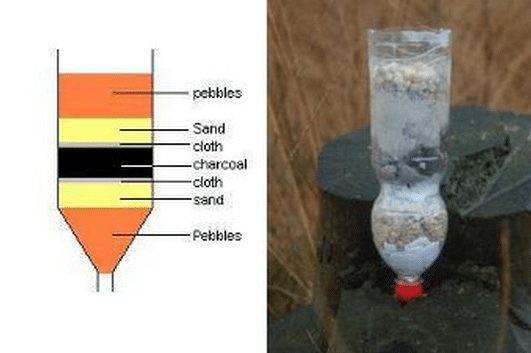

This image is property of www.engineeringforchange.org.
3. Try DIY Filtration Systems
3.1 DIY Cloth Filtration
Another cheap and accessible way to filter your water is by using a DIY cloth filtration system. This method is particularly useful in situations where access to commercial filters or advanced equipment may be limited. To create a DIY cloth filter, you’ll need a clean cloth or fabric, a container, and a way to secure the cloth over the container’s opening.
Start by cleaning the fabric thoroughly to remove any dirt or contaminants. Ensure the fabric is large enough to completely cover the opening of the container. Secure the fabric tightly over the container’s opening using a rubber band or string, making sure there are no gaps.
To filter the water, pour it slowly through the fabric-covered opening, allowing it to pass through the cloth and into the container below. The fabric will help remove larger particles and debris, improving the clarity of the water. However, keep in mind that this method may not remove all contaminants, so it is important to use it as a temporary solution or in conjunction with other filtration methods.
3.2 DIY Sand and Gravel Filtration
If you have access to sand and gravel, you can create a simple yet effective DIY sand and gravel filtration system. This method is particularly useful for filtering larger impurities and can be easily constructed using basic materials.
To create a DIY sand and gravel filtration system, you’ll need a container, a small piece of cloth or fine mesh, clean sand, and gravel. Start by cleaning the container thoroughly to remove any contaminants. Place the cloth or fine mesh over the container’s opening to act as an initial barrier for larger particles.
Next, carefully layer the container with a few inches of clean gravel. The gravel will act as a coarse filter, removing larger impurities from the water. On top of the gravel, add a layer of clean sand. The sand will act as a finer filter, removing smaller particles and debris from the water.
To filter the water, slowly pour it through the layers of gravel and sand, allowing it to come out clean and purified at the bottom of the container. Remember to clean and replace the sand and gravel periodically to ensure the effectiveness of the filtration system.
4. Explore Natural Filtration Methods
4.1 Use Activated Carbon
Activated carbon, also known as activated charcoal, is a natural substance that can help filter and purify water by adsorbing impurities. It is widely used in commercial water filters and can be purchased in powdered form or in granules. To use activated carbon as a filtration method, you can create a simple homemade filtration system.
Start by thoroughly cleaning a container that is large enough to hold the desired amount of water. Place a layer of clean sand at the bottom of the container, followed by a layer of activated carbon. The activated carbon will help remove contaminants such as chlorine, heavy metals, and organic compounds.
Add another layer of sand on top of the activated carbon, followed by a layer of fine gravel. These additional layers will help further filter the water and prevent the activated carbon from escaping. Slowly pour the water you wish to filter into the container, allowing it to pass through the layers of activated carbon, sand, and gravel.
4.1. Use Activated Carbon Activated carbon, also known as activated charcoal, is a natural substance that can help filter and purify water by adsorbing impurities. It is widely used in commercial water filters and can be purchased in powdered form or in granules. To use activated carbon as a filtration method, you can create a simple homemade filtration system.
Start by thoroughly cleaning a container that is large enough to hold the desired amount of water. Place a layer of clean sand at the bottom of the container, followed by a layer of activated carbon. The activated carbon will help remove contaminants such as chlorine, heavy metals, and organic compounds.
Add another layer of sand on top of the activated carbon, followed by a layer of fine gravel. These additional layers will help further filter the water and prevent the activated carbon from escaping. Slowly pour the water you wish to filter into the container, allowing it to pass through the layers of activated carbon, sand, and gravel.
4.2 Try Tumeric Powder
Turmeric, a commonly used spice in cooking, can also be harnessed for its natural filtration properties. Turmeric contains a compound called curcumin, which has been found to possess antimicrobial, anti-inflammatory, and antioxidative properties. To utilize turmeric powder for water filtration, follow these steps:
First, thoroughly clean a container that is suitable for holding the water you wish to filter. Fill the container with the water, ensuring that it does not exceed the maximum capacity. Next, add around one teaspoon of turmeric powder for every two liters of water.
Allow the turmeric powder to settle in the water for at least one hour. During this time, the curcumin compounds will work to purify the water by inhibiting the growth of bacteria and neutralizing harmful toxins.
After the settling period, carefully pour the water through a fine mesh strainer or cheesecloth to remove any undissolved turmeric residue. The filtered water can then be transferred to a clean container and consumed.
4.3 Utilize Moringa Seeds
Moringa seeds, derived from the drumstick tree, are another natural option for filtering water. These seeds contain cationic polyelectrolytes, which help to flocculate suspended particles and reduce turbidity. Here’s how you can use moringa seeds for water filtration:
Thoroughly clean a container that is large enough to hold the water you want to filter. Fill the container with the water, ensuring it doesn’t exceed the maximum capacity. Add a handful of moringa seeds (approximately 5-7 seeds per liter of water) to the container.
Allow the seeds to settle in the water for at least two hours. During this time, the seeds will release their natural coagulants, which will help attract and bind with impurities.
After the settling period, gently pour the water into another clean container, taking care not to disturb the sediment at the bottom. If desired, you can strain the water through a fine mesh strainer or cloth to remove any residual particles.
It’s important to note that while moringa seeds can effectively reduce turbidity, they may not adequately remove all types of contaminants. Therefore, it’s advisable to combine this method with other filtration or purification techniques for optimal results.
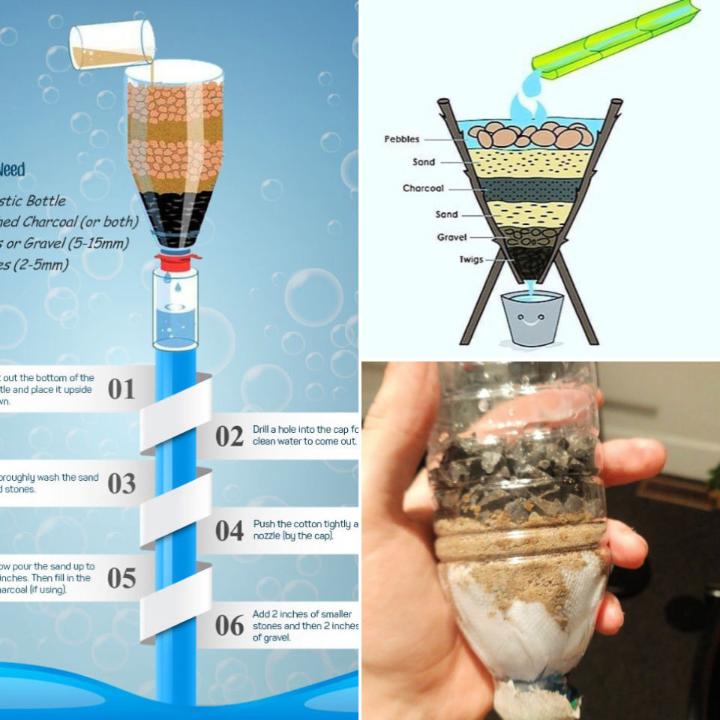

This image is property of cdn.itsoverflowing.com.
5. Consider UV Light Sterilization
5.1 How UV Light Sterilization Works
UV light sterilization is a highly effective method for purifying water by destroying the DNA of microorganisms and rendering them unable to reproduce. This technology utilizes ultraviolet (UV) light, specifically the UV-C wavelength, to kill bacteria, viruses, and protozoa.
UV light sterilization can be achieved through the use of small handheld devices or larger systems designed for whole-house or commercial use. To purify your water using UV light sterilization, simply pass the water through a UV chamber or expose it to a UV light source for a specific period of time, depending on the manufacturer’s recommendations.
UV light sterilization is a chemical-free and eco-friendly method of water purification. However, it should be noted that UV light does not remove physical particles or chemical contaminants from the water. Therefore, it is advisable to use UV light sterilization in conjunction with other filtration methods for comprehensive water purification.
5.2 Affordable UV Light Sterilization Options
If you’re considering using UV light sterilization to purify your water, there are several affordable options available on the market. Many handheld UV water purifiers are compact, lightweight, and designed for outdoor enthusiasts or individuals who frequently travel.
These portable devices typically utilize UV-C LEDs to provide a quick and efficient method of water sterilization. They are easy to use and require minimal maintenance. Some models even come equipped with built-in filters to remove larger particles or activated carbon to improve taste.
For whole-house or larger-scale UV light sterilization, there are also affordable UV sterilization systems available. These systems are typically installed at the point of entry, providing comprehensive water purification for the entire household. Many brands offer affordable options that are designed to be user-friendly and require little to no maintenance.
6. Investigate Water Purification Tablets
6.1 How Water Purification Tablets Work
Water purification tablets are a convenient and affordable method of ensuring your drinking water is safe and clean. These tablets are typically made with chemicals such as chlorine dioxide or iodine, which are effective at killing bacteria, viruses, and protozoa. They work by releasing these chemicals into the water, effectively disinfecting it.
To use water purification tablets, simply follow the instructions provided by the manufacturer. Typically, you’ll need to drop one tablet into a specific volume of water and allow it to dissolve completely. The water should then be left undisturbed for a certain period of time to allow the disinfection process to take place.
Water purification tablets are especially useful for individuals who are traveling or camping in areas where clean water may be scarce or contaminated. They are lightweight, compact, and easy to carry. It’s important to note that while water purification tablets are effective at killing harmful microorganisms, they may not remove physical particles or chemical contaminants from the water.
6.2 Affordable Water Purification Tablets
When it comes to affordable water purification tablets, there are several reputable brands available on the market. These brands offer tablets that are specifically formulated to provide safe and clean drinking water in various situations.
Some brands offer compact and lightweight tablets that are designed for emergency preparedness or outdoor activities. These tablets often come in individual packets, making them convenient for carrying in a backpack or emergency kit.
Other brands offer larger packages of water purification tablets that are suitable for longer trips or group use. These economical options often provide a higher number of tablets at a lower cost per tablet, making them a cost-effective choice for individuals or families seeking affordable water purification solutions.
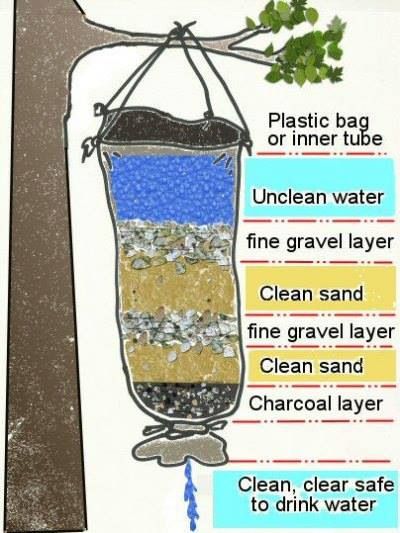

This image is property of www.earthlymission.com.
7. Install Faucet Filter Attachments
7.1 Inexpensive Faucet Filter Attachments
Faucet filter attachments are a popular and affordable option for filtering your tap water directly at the source. These attachments are designed to fit onto your existing faucet and can be easily installed without the need for plumbing modifications. They typically utilize a combination of activated carbon and other filtering media to remove impurities.
When choosing an inexpensive faucet filter attachment, look for reputable brands that have been independently tested and certified by recognized organizations. These certifications ensure that the filter effectively removes certain contaminants and meets industry standards.
Some faucet filter attachments also come equipped with additional features, such as multiple filter stages or adjustable flow rates. These features can help improve the overall performance and user experience of the faucet filter attachment.
7.2 Easy Installation Process
Installing a faucet filter attachment is a simple process that requires no special tools or plumbing skills. Most attachments come with step-by-step instructions, along with any necessary adapters or washers to ensure a proper fit on your faucet.
To install a faucet filter attachment, start by removing any pre-existing aerators or adapters from your faucet. This will allow for a direct connection between the filter attachment and your faucet. Next, attach the filter securely to your faucet, ensuring that it is tight and does not leak.
Once the filter attachment is installed, it is recommended to run the water for a few minutes to flush out any carbon fines or initial debris from the filter. This will help ensure that you are receiving the cleanest and freshest filtered water possible.
8. Build a DIY Berkey-like System
8.1 Materials Required
If you’re looking for a budget-friendly alternative to the popular Berkey water filtration system, consider building a DIY Berkey-like system. This DIY project allows you to create a similar filtration system using affordable and readily available materials.
To build a DIY Berkey-like system, you’ll need the following materials:
- Two food-grade buckets with lids – one larger bucket to serve as the upper chamber and one smaller bucket to serve as the lower chamber.
- Two food-grade ceramic or stainless steel water filters – these can be purchased online or at a local store specializing in water filtration supplies.
- Plastic spigot – for convenient access to the filtered water.
- Food-grade silicone sealant – to ensure a watertight seal.
- Overflow tube – to prevent overfilling of the upper chamber.
8.2 Step-by-Step Instructions
To build your own DIY Berkey-like system, follow these step-by-step instructions:
- Thoroughly clean and sanitize both buckets and their lids.
- Use the food-grade silicone sealant to create a watertight seal around the hole in the bottom of the upper bucket. Insert the plastic spigot and tighten it securely.
- Place the ceramic or stainless steel water filters in the upper bucket, making sure they are secure and centered.
- Position the overflow tube in the upper bucket, ensuring it is inserted near the top but not touching the lid.
- Stack the smaller bucket (lower chamber) onto the larger bucket (upper chamber) and align the holes in their lids.
- Fill the upper bucket with water, allowing it to filter through the ceramic or stainless steel filters into the lower chamber.
- The filtered water can be accessed through the spigot in the lower chamber.
By building a DIY Berkey-like system, you can enjoy the benefits of a gravity-fed water filtration system without the higher cost associated with commercial options. Remember to clean and replace the filters regularly to maintain optimal filtration performance.


This image is property of i.ytimg.com.
9. Opt for Reusable Water Bottles with Built-in Filters
9.1 Types of Reusable Water Bottles with Filters
An easy and cost-effective way to filter your water on the go is to invest in reusable water bottles with built-in filters. These bottles are designed to filter water as you drink, providing you with clean and refreshing water wherever you are.
There are several types of reusable water bottles with filters available:
- Straw-style filter bottles: These bottles feature a built-in straw that contains a filter, allowing you to drink directly from the bottle. As you sip, the water is filtered through the straw, removing impurities and improving taste.
- Squeeze bottles with filters: These bottles typically have a built-in filter placed at the mouthpiece. To drink, you simply squeeze the bottle, forcing the water to pass through the filter before reaching your mouth.
- Pressurized bottles with filters: These bottles utilize a pump or pressurization system to force water through the filter. By creating pressure, the water is pushed through the filter, resulting in clean, filtered water.
9.2 Cost-Effective Options
When it comes to cost-effective reusable water bottles with built-in filters, there are plenty of options to choose from. Many reputable brands offer affordable filter bottles that provide reliable filtration while being budget-friendly.
Consider looking for water bottles with replaceable filters, as this can help extend the lifespan of the bottle and reduce long-term costs. Replacement filters are usually sold separately and can be easily installed into the bottle when needed.
Additionally, some manufacturers offer filter bottle bundles or multipacks, allowing you to purchase multiple bottles at a discount. This is a great option if you have multiple family members or if you want to have filtered water available in different locations.
Remember to regularly clean and maintain your filter bottle according to the manufacturer’s instructions to ensure optimal performance and longevity of the filter.
10. Take Advantage of Pitcher Filters
10.1 Affordable Pitcher Filter Brands
Pitcher filters are a popular and cost-effective way to filter tap water at home. These convenient filters consist of a water pitcher with a built-in filter cartridge that removes impurities as the water passes through. There are many affordable pitcher filter brands available on the market that provide trusted filtration and value for money.
One top-rated and affordable pitcher filter brand is Brita. Brita offers a range of pitcher filters in various sizes, including models suitable for individuals or families. Their filters utilize activated carbon and ion-exchange technology to reduce chlorine, heavy metals, and other contaminants that can affect taste and odor.
Another reputable and budget-friendly pitcher filter brand is PUR. PUR pitchers feature activated carbon filters that are certified to remove up to 99% of lead, along with other common contaminants. They offer pitchers in different capacities to suit your household’s needs.
Both Brita and PUR pitcher filters are readily available at most grocery stores, big-box retailers, and online platforms. They often come with multiple filter cartridges, providing months of filtered water at a fraction of the cost of bottled water.
10.2 How to Properly Use a Pitcher Filter
Using a pitcher filter is a straightforward process that requires minimal effort. To properly use a pitcher filter, follow these steps:
- Remove the pitcher’s lid and insert the filter cartridge into the designated slot in the reservoir. Make sure it fits securely.
- Flush the filter cartridge by rinsing it under cold, running water for a few seconds to remove any loose carbon fines.
- Fill the pitcher with tap water, pouring it directly into the reservoir. Avoid overfilling to prevent water overflow when the lid is replaced.
- Allow the water to pass through the filter cartridge by placing the lid back on the pitcher. The filtered water will collect in the lower portion of the pitcher.
- Once the water has passed through the filter, it is ready to be poured and consumed. It is important to note that pitchers have a limited capacity and will need to be refilled as needed.
Remember to replace the filter cartridge according to the manufacturer’s guidelines. Typically, pitcher filters need to be replaced every 2-3 months, depending on the household’s water usage and the specific filter brand. Removing and replacing the filter cartridge is usually a simple process that can be done by following the instructions provided by the manufacturer.
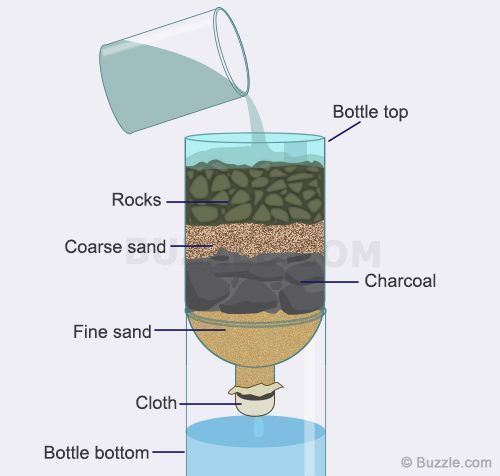

This image is property of i.redd.it.

